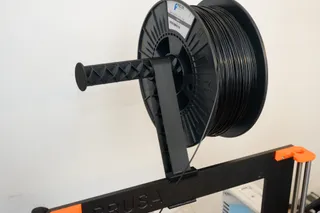R4G Extruder for Prusa, a DIY Bondtech Upgrade / Geared Extruder
Description
PDFThis is the R4G extruder for Prusa printers, where the G stands for Greg or Geared. It's a DIY "Bondtech upgrade" that requires a very limited set of additional parts.
It is derived from the Prusa R4 extruder of the MK3S (https://github.com/prusa3d/Original-Prusa-i3/tree/MK3S) and uses its opto-mechanical filament sensor. However you can also use it without any filament sensor.
The design is somewhat beta, venture here only if you are adventurous
In additon to what you get with a MK3S, you will need :
- 1x Bondtech shaft assembly
- 1x Bondtech motor drive gear
- 2x 5x8x2.5 mm bearings
- 2x DIN 562 M3 square nuts (+ some extras to cover those you won't be able to extract from the original printed parts)
- 1x M3x18 screw
1x PTFE tube
You can get the Bondtech parts from a BMG extruder or purchase them individually as spare parts.If you want to just test the setup you do not need to invest in a pancake stepper motor but for long term use it's a clear advantage to have one.Motor shaft length must be maximum 20 mm. If you wan't to use a motor with a shaft length that is more than 20 mm, increase the height of the spacer when you print it (22 mm shaft -> 2.6 mm spacer). You may need to increase the length of the 3 screws that hold the motor too.
Avoid to purchase a 0.9° stepper they offer no advantage in this setup and will likely degrade the quality of your print (the culprit is their strong magnets). One stepper motor I can recommend is the one you see on the photos it's a 17HS10-0704S. It's the one supplied by Bondtech and it's made by Oyo Stepper Motors (https://www.oyostepper.com)
Assembly is very similar to the R4 extruder so you can follow Prusa online instructions.
Start by printing theR4G-bearing-fit-test-piece.stl and check that the bearing fits well inside without any play. If it's too tight (over extrusion) or too lose (under extrusion) adjust your extrusion multiplier until you have a good fit. This is to ensure that you do not discover that the bearings don't fit when you have printed the whole body...
Start by installing the bearings in each part of the extruder.
- Put the M3 square nut that holds the print fan support (the slot is in the opening for the stepper motor). Use a small allen key to push it in place.Check with a screw that it's in the correct place because after installing the motor you won't be able to push it further
- Insert the shaft assembly from the bottomwithout the filament driving gear.
- Install the Bondtech filament driving gear on the shaft, the groove for the filamentmust be at the top
- Align the gear with the filament path. Since in this setup the filament driving gear will auto align itself (the shaft slides in the bearings), make sure that the shaft can move a bit on each side of its ideal position
- Install the stepper with the motor drive gear (tightening screw of the gear shall be away from the motor)
- Attach the motor with 2xM3x10 screws at the bottom (same as the R4) and 1xM3x18 for the top right hole
- Put a PTFE tube in the groove and check if the end of the motor shaft touches it (this depends on the length of the shaft and the size of the bevel at its end). If it touches you will need to slightly carve the PTFE tube or you can insert the suppliedR4G-stepper-motor-spacer-0.6mm.stl between the motor and the extruder body.
Assemble the idler by pushing the shaft through the "strong" side of the idler. The filament groove must also be on the "strong" side
From here you should be able to make you way with the R4 instruction assembly (https://manual.prusa3d.com/Guide/5.+E-axis+assembly/1055?lang=en).You will also need to change the PTFE tube so it is flush with the gears when you install it (approx. length 62.5 mm). It's highly recommended to use a collet clip on the coupling, alternatively you can put some adhesive tape on the PFTE tube where it exits the hotend radiator so it will be clamped when you assemble the 2 parts of the body.Without that, your PTFE tube will move and will get quickly dammaged by retractions/de-retractions.
Since you now have a geared extruder, you need to change some settings on the printer: Changing eSteps/mm is a must, changing maximum feed rate is highly recommended (because you have a 3:1 geared extruder, motor will rotate 3x faster to achieve the same feedrate).
Changing max feedrate for extruder :
M203 E40 (set the max feed rate to 40mm/s, 1/3rd of the stock value, higher value may work too but you need to experiment)
eSteps on the MK3(S)M92 E830
M500 (to save the settings in the EEPROM)
On the MK2M92 E415
M500
If you like to print fast on a MK3(S), the default 830 steps/mm may be a limit. You can go the following route to avoid that :Set your defaults as indicated above
In your slicer startup gcode add :
M350 E16
M92 E415
M203 E80
This will set extruder motor to 16 microsteps (vs. default 32) and adjust eSteps/mm and maximum feedrate accordingly. Microstepping is not saved in the EEPROM, that's why this needs to be in your startup gcode.CREDITS :
Prusa R4 extruder : https://github.com/prusa3d/Original-Prusa-i3/tree/MK3S
- CAD model for Bondtech gears : https://github.com/BondtechAB/Bondtech\_Prusa\_i3
R4G extruder is licensed under GNU GPL v3.0
Print instructions
Category: 3D Printer Parts Print Settings
Printer Brand: Prusa
Printer: I3 MK3S
Supports: No
Resolution: 0.200
Infill: 15%
Notes:
3 perimeters, 5 top and bottom layers
Tags
Model origin
The author marked this model as their own original creation. Imported from Thingiverse.

